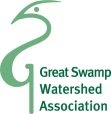By Jim Northrop, GSWA Member
The Dilemma: Nature or Technology?
In 1959, it was discovered that the Port Authority of New York and New Jersey was developing plans to acquire the land we call “The Great Swamp,” and there to construct a "jetport." Their aims were ambitious, and their jetport would be one of the largest in the world. Many residents of the area were up in arms, but they were opposed by powerful pro-business interests.
In time, however, a defensive strategy emerged -- transfer as much land as possible from strategic places in the middle of the Great Swamp, to the Federal Government, for use as a wildlife sanctuary. It was believed this would keep the land out of the reach of the Port Authority, and thus defeat the jetport plan.
A Captain of Industry Becomes Engaged In Open Space Issues
After 1907, when M. Hartley Dodge married Geraldine Stillman Rockefeller, youngest daughter of William Rockefeller, brother of John D. Rockefeller and a founder of Standard Oil Company (NJ), the young couple became among the largest landowners in the Great Swamp area. It was known that Dodge was a generous donor of land to the newly-formed Morris County Park Commission. In 1957, Mr. Dodge and others donated over 50 acres to the Morris County Park Commission for Loantaka Park, the first link in the Loantaka Brook Reservation. But the actual extent of his concern for saving the Great Swamp was not revealed until later.
Dodge was the retired Chairman of the Board of the Remington Arms Company and had served for many years as a Director of the Equitable Life Assurance Society, and the Delaware, Lackawanna & Western Railroad. He was also a member of various other boards. He lived in Madison Borough and made substantial contributions (usually anonymously) to local causes. Born in 1881, “Marcy” Dodge was a friend of the rich and famous, and was descended from a founder of the Phelps-Dodge Corporation.
Wednesday, September 16, 2009
Friday, September 4, 2009
Living Streamside
GSWA is introducing a new educational series this fall on what homeowners can do to protect the streams, ponds, lakes and wetlands that flow into the Great Swamp. We will tell you how you can prevent everyday products from contaminating our waterways, how you can have a “green” yard, and how you can conserve water. For instance, did you know you could make a difference by switching to a dishwasher detergent containing little or no phosphates? Phosphorus accelerates plant growth in our ponds and streams, reducing oxygen needed to support fish and other organisms. The actions of every one of us affect the health of our water. You don't have to live on a stream to develop good streamside living practices.
If you have already taken steps to protect the watershed, share your tips with us. Post your comment.
If you have already taken steps to protect the watershed, share your tips with us. Post your comment.
Subscribe to:
Posts (Atom)

